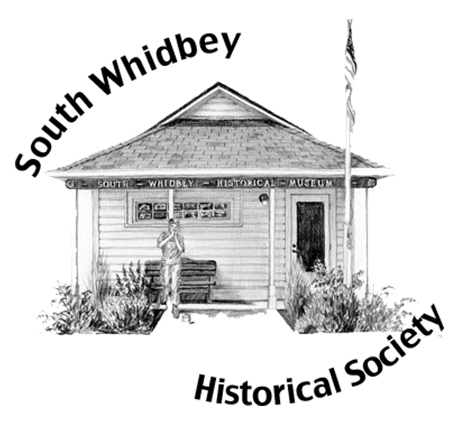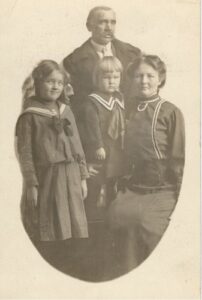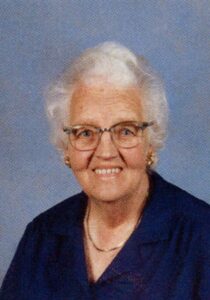The Daughters of Norway, Ester Moe Lodge, are having their Nordic Bakery and Boutique Sale at St. Peter’s Lutheran Church in Clinton this Saturday, Nov. 12 between 10 a.m. and 3 p.m. Stop on by for this popular local event.
We thought you might like to know a little more about who the Lodge was named after: Ester Anderson Berquist Moe.
Remembrances of Ester (Anderson) Moe (1905-1995)
Ester Anderson came to Whidbey Island in 1906 as the one-year-old daughter of Bertine and Anders “Graveyard” Anderson, well known Langley pioneers. Bertine had emigrated from Norway, and Anders from Sweden.
Her parents were living in Great Falls, Montana where Ester’s father worked at a mine smelter, when Ander’s aspiration of being a farmer farther west won out. They took the train to Seattle, where they saw an advertisement of land for sale in Whidby Island. After taking a boat ride to Langley, he purchased 20 acres from Langley founder Jacob Anthes.
Ester often referred to herself as the gravedigger’s daughter. Why her father’s nickname? There was another Anderson family in Langley, and to differentiate the two men, they were called by their occupations: one was Anton “Blackie” or “Blacksmith” Anderson, the blacksmith. Ester’s father was called “Graveyard” Anderson because the family lived adjacent to the new Langley Woodmen Cemetery and her father dug graves and was the caretaker there.
Ester lived most of her life on South Whidbey. She taught at Deer Lake School in Clinton, was the Secretary for the Clinton Progressive Association, taught Sunday School and was choir director at St. Peter’s Lutheran Church, and served as the Clinton Postmaster for 29 years.
The local chapter of the Daughters of Norway was formed in 1995 and is named the “Ester Moe Lodge” in her honor.
Here is an excerpt from the memoir which Ester wrote in 1976…
“Langley was as large in 1906 as it is today in 1976. On the waterfront side of First Street were two hotels. The building which is now the Dog House Tavern was the general store, post office, and pool hall; upstairs was the big hall with a lovely floor and big stage. In the basement was the town gymnasium. The school used the gymnasium for many years before one was built on the school grounds.
Mr. Henry Weber was the butcher. He was a German immigrant and had an excellent meat market (“butcher shop” we called it).
Mr. Foster was the barber. Then there was the village blacksmith, Anton Anderson. Everyone called him “Blacksmith” Anderson. His first shop stood where the Methodist Church is located.
I loved that blacksmith shop. People came from Bayview, Maxwelton and Clinton to have their wagon wheels repaired and their horses shod. It was always warm there, and he had a little room with a cot, table, a few chairs and a stove. The coffeepot was always on the back of the stove and a few goodies were on the table.
On the wall was a picture of many kinds of fish. I knew the names of all of them. Blacksmith Anderson was also quite a fisherman. He knew where all the rock-cod beds were located and the red-snapper’s homes.
Then there was a large livery stable, where Mr. Brehm had horses for rent and he delivered freight which came by boat. The large wagon was also the hearse at funerals. Later, there was a second blacksmith’s shop.
Across the street was another store, where Clyde’s Garage is now located, and the parsonage with a huge pink azalea bush in the yard. The only church in Langley was the Friends Church on upper First Street where the Bucklews now live.
On Anthes Avenue was a bank, Langley State Bank, a telephone office, Funk’s Mercantile, the High School, Uncle Hughie’s (Hugh McLeod’s) Lawyer’s Office, a creamery, and the town Pump. It was built like a little pergola with seats around the sides, a pump in the middle, and the old tin cup. It was quite a gathering place for old and young alike. No one had running water in their homes. I stopped there many times to get a drink. No one thought of germs; I guess the air and sunlight killed them all. We also had a doctor, Dr. Craig, and a real estate office.
At the foot of the hill was the Langley Dock. It was built in the shape of a “U.” You could drive out with your horse and wagon and back on the other side. I drove old Prince down there many times with a wagon of crates of strawberries to be shipped to Everett on the boat.
At the open end of the U-shaped dock was a little confectionery called “The Sea Breeze.” Phil Simon owned this little store and his home was across the road. It sure was a treat after walking from the farm to the dock to have an extra nickel for an ice cream or a box of Cracker Jacks.
Phil Simon owned two launches, “The Captor” and “The Caprice.” We would take groups of people to Camano Island or Hat Island for picnics for a minimal fee. I can remember going with my parents on one of his launches to Everett to hear Billy Sunday (a popular evangelist). So even though we had no cars, no ferries, no Deception Pass Bridge — we were not completely isolated.
Ted Howard had the first car in Langley. He certainly was kind. Every day after school, he would take a few children for a ride. When your turn came, what a thrill! He ran a taxi-service for many years. He met all the boats, and if you had an extra quarter, riding was certainly easier than walking.
A boat made two round trips to Everett daily. The boat landed at the city dock at the foot of Hewitt Avenue. I was not very old when I could go to the dentist (in Everett) by myself.
Another boat made one round trip a day to Seattle. These boats carried freight, mail and passengers. The Seattle boat left Oak Harbor at 6:30 a.m. and made the following stops — San de Fuca, Coupeville, Saratoga, Mabana on Camano Island, Langley, Clinton, Glendale and Possession.
The crew stayed on the boat, so they employed a cook, and there was a nice galley where you could have something to eat. I wish we still had this service, but with the arrival of the ferries, the boats had to go.”
—(End of Chapter 1, written by Ester Moe in 1976)
And here is a recollection she wrote about childhood illnesses on South Whidbey before modern medicine:
“My first childhood disease was whooping cough. It was in the winter, the snow was on the ground and we were living at the brush camp near Saratoga in a one-room shack. I was about 4 years old, but, oh how I whooped! My father drove into Langley and got some medicine from Dr. Craig, but my mother said I coughed until spring…
My brother had croup when he was a little fellow. My mother would get up and light the lamp and heat some lard in a dish over the lamp chimney and pour it down his throat… (With croup) it sounds like they are choking to death, and I screamed and cried the whole time. I didn’t want anything to happen to my little brother.
When I was 8 years old, I had chickenpox, and I was covered from head to foot. I have a number of bad scars. Every morning and night I stood on a chair and my mother covered me with some black ointment. When he scabs were healed they gradually fell off, but my mother had to pull them out of my hair. That was quite an operation.
Next was a bout with red measles. I stayed in bed with the blinds drawn and the door shut. A tiny speck of light was so painful (that) I’d scream. They had to put a rug against the door, as there was a tiny space between the door and floor. My brother (Albert) had to wear glasses for a number of years after his bout with the measles.
Then there was the epidemic of mumps. One morning I was awakened and my jaws were swollen. My mother said, “Eat this pickle. If you have mumps, you can’t swallow it.” I couldn’t. “We have to keep your neck warm and you’ll be alright.”
So my mother made a few pancakes. She put a hot pancake on either side of my face, took a dishtowel and put it under my chin and tied it up on my head. The heat felt really good. When the pancakes cooled a bit, they were replaced with hot ones. The skillet stood on the back stove all day and the pancakes heated again and again. I recovered, but for many years I never ate pancakes. They smelled like mumps to me.
The year I was 13 and my brother 8, we had scarlet fever. I was sick, but Albert was much worse. My father was working in Everett, so my mother walked downtown and got the doctor. We had no telephone. I can still see that medicine. It was yellow with some white material suspended in it.
I was scarlet color over my entire body, and my throat bright red. I lost the skin on my elbows and knees, but I’m sure my brother lost all his old skin as the sheets were filled with patches every morning. I don’t see how my mother took care of the farm and two sick kids, but somehow she made it.
When I was attending Bellingham Normal School in the fall of 1921, a number of smallpox cases were reported just before Christmas vacation. We were all told to be vaccinated during vacation. My father didn’t believe in vaccination and the day I returned to college, I had smallpox. I was very sick, but never really broke out, but my little cousin who was 2-years-old was just covered. I felt so badly because I was sure she caught it from me, but (other than the pustules) she didn’t act sick at all…
We could never have managed without the “Watkins Man,” Mr. (Lemuel) Cunningham. He came once a month and we bought liniment for humans, horse liniment, pretty pink cold tablets, ointments of various kinds, and vanilla and spices. We loved the “Watkins Man.” He had a package of gum for all the kids.
We were very fortunate in the Langley area during the 1918 flu epidemic to have a fine country doctor, Dr. Barry. He was an old Army doctor and had served many years in Mexico. He lived in the large white house at the foot of the hill on Anthes Avenue.
My father was working in Everett. My brother got the flu first. He was 8 years old and so sick. My mother tried various remedies with no success. She sent me to Langley to get the doctor. I didn’t feel very well myself so I rode on old Prince (the family workhorse). When I got to the top of the hill, I saw Dr. Barry backing out of his driveway in his big touring car. I screamed at the top of my lungs, “Please wait, my brother is dying!” I kept screaming and he heard me. He told me to wait there until he saw my brother and then I could take the medicine home.
I just sat on the horse and waited. He gave me medicine for Albert and some capsules for me. He could see I wasn’t well.
On the way home I became so dizzy that I fell off the horse. Picking myself up, I led the horse home, put him in the barn, went to the house and right to bed. My brother was so weak. He just lay there and couldn’t even talk. In a couple of days, though, he was much better…
There were only two deaths in our area. One was a baby who developed pneumonia. We owe a debt of gratitude to Dr. Barry. He worked day and night to save us all.”
——
Alas for Ester: both children she had with her first husband, Carl Berquist, died young: a baby girl (Barbara May) who lived only a few days, and a son, Billy, who died of appendicitis when he was not quite 8 years old, in 1939. She did not have children with her second husband, John Moe.
——————–
In addition to being a schoolteacher, Ester was the President of the Deer Lake PTA. As a teacher, she participated in community activities, and Ester was in charge of many programs such as operettas, plays and basket socials, which were held in the Clinton Progressive Hall.
She was active in St. Peter’s Lutheran Church from 1923 on and served as a Sunday School teacher to three generations, and was also the organist and choir director. She conducted Bible study classes for women and even occasionally gave the sermon. Ester was also the Secretary of the Clinton Progressive Association in 1928.
President Franklin Delano Roosevelt appointed Ester as Postmaster of the Clinton Post Office, where she served for 29 years until she retired. She also served for many years as a Democratic Precinct Committeewoman.
Feel free to share your memories of Ester in the comments section below.




